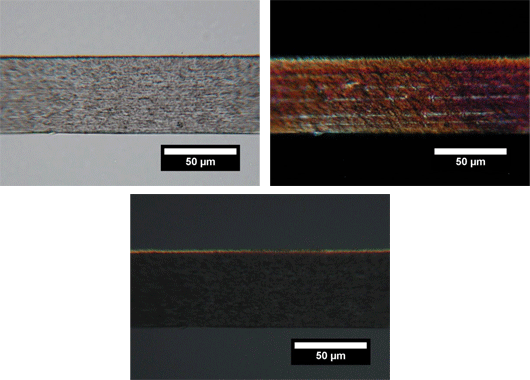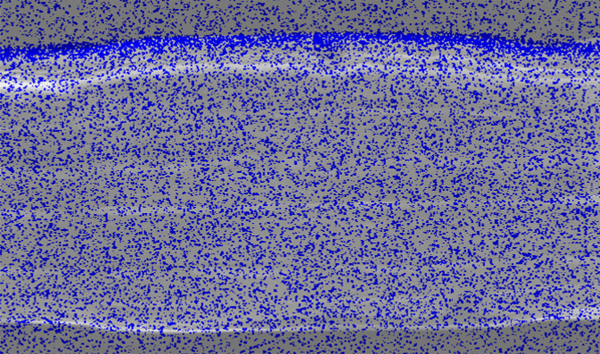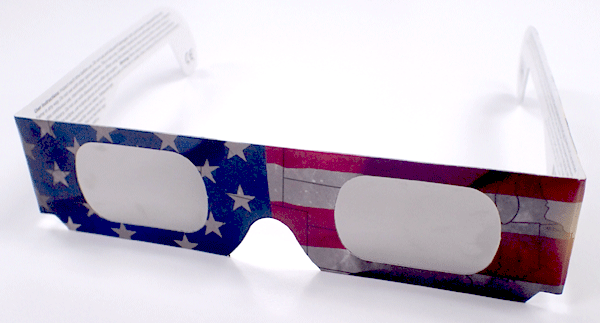Structure of Eclipse Glasses: How are they made?
With a total solar eclipse due to pass across the US on the 8th of April, 2024, all of us at Microtrace were surprised to find that the eclipse could be seen through even a decent layer of clouds – with glasses. While discussing the eclipse over lunch, we started to wonder about the construction of a pair of disposable eclipse glasses and how they were made. A quick search on the internet showed that there isn’t a whole lot of information. These glasses (filters) are designed to transmit no more than 0.00032% of the sun’s light according to the ISO 12312-2 standard which governs their design. This is a stronger filter of light than most welding goggles. Ultimately, the filter acts as an exceptional neutral density filter that is opaque to all but the strongest sources of light.
Since we spend a lot of time looking at the finest details of all sorts of everyday materials, we thought we’d take a look at these goggles to see how they were produced and what makes them nearly opaque. Depending on how often you think about these things, what we found may not be a surprise, but nonetheless, we thought it was interesting enough to share.
First, here’s a pair of eclipse glasses that were given to one of our scientists as a gift. They were purchased for $1 at a megastore. They are noted to comply with the ISO 12312-2:2015 standard (Eye and face protection — Sunglasses and related eyewear — Part 2: Filters for direct observation of the sun).

Cross section of solar eclipse glasses. This thin cross section was cut from a pair of commercially available eclipse glasses by Microtrace using a microtome. the layered polymer structure can be seen in transmitted light (upper left), between crossed polars (upper right), and in reflected light (lower) where a reflective metallic layer can be seen.
We cut a cross section of one of the filters to take a look at its construction. From the transmitted light image of a thin section (above, left), we can see that the eclipse filter consists of two layers. The majority of the filter thickness (about 2 mil / 55 micrometers) consists of an oriented (center) polymer that has been darkened with carbon black. The main tinting agent; however, is a thin, reflective, metallic layer that can be observed in the reflected light image (lower). This metallic layer is only on the order of 2 micrometers thick (for reference, a typical head hair is about 40 times thicker).

Map of nickel distribution in a thin section cut from the lens of a pair of eclipse glasses. The blue pixels, concentrated in a layer at the top of this image, indicate the presence of a nickel-rich metal layer that provides much of the light attenuation provided by a typical pair of eclipse glasses.
An elemental analysis of this thin section using an energy dispersive x-ray spectrometer on a scanning electron microscope (SEM/EDS) shows that the thin, metallic layer is a layer of nickel metal (with lesser amounts of chromium and iron). Together, this thin metal film is claimed to be sufficient to block out a safe amount of the sun’s intensity. The above elemental map shows the presence of nickel (blue pixels) concentrated in an upper layer of the film.
While higher resolution images could be prepared to obtain more specific measurements of film thickness, more detailed cross sections could be used to study the film layers in more detail, and spectroscopic analyses could be conducted to determine if this film is successful at filtering out the 99.999 percent of sunlight across the relevant portion of the visible and ultra-violet spectrum, this analysis addresses some basic questions about how the glasses work and how they were made.
With these approaches, it’s possible not only to understand how the filter is constructed, but also to scientifically test the efficacy of eclipse glasses. Surely the reports of fraudulent glasses (even going so far as to incorporate notations implying compliance to ISO standards) will be the origin of some lawsuits and probably (though hopefully not) some damaged eyes.
Finally, if you get this far and you are done with your eclipse glasses, please send them to us. If we get enough, we will analyze them and put together a talk about the glasses and their variation. If you are willing to send them to us (Microtrace LLC, 790 Fletcher Drive, Suite 106, Elgin, IL 60123) and provide a return address , we will send you a small thank you gift!
Please note, the above information on this page was assembled only for information purposes and is not intended to (nor should it) be used for any legal purpose.
How May We Help You?
Contact usto discuss your project in more detail.








